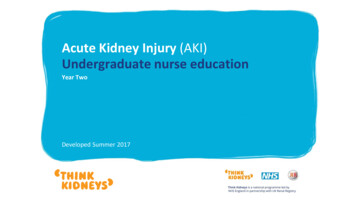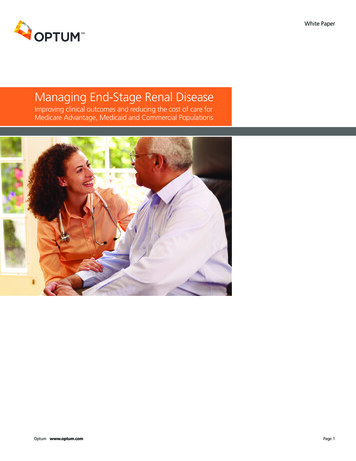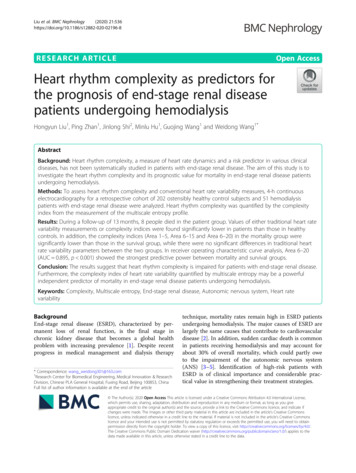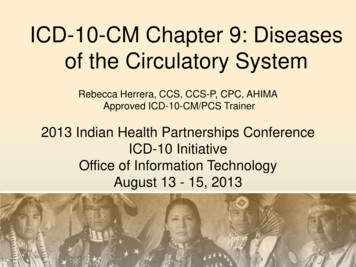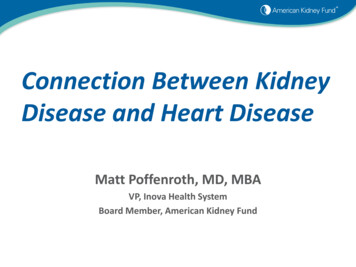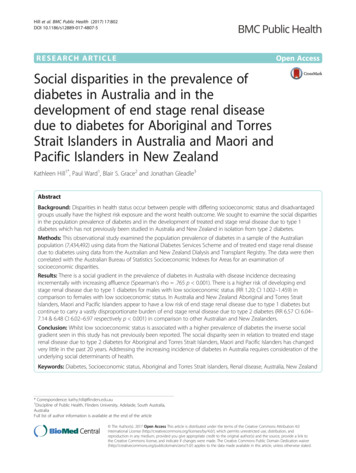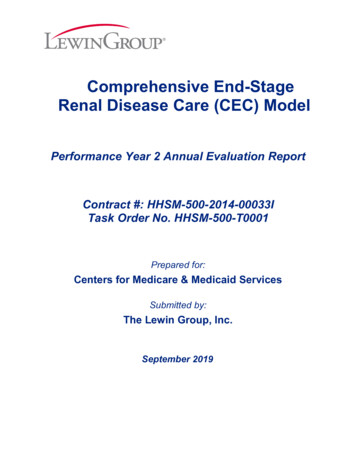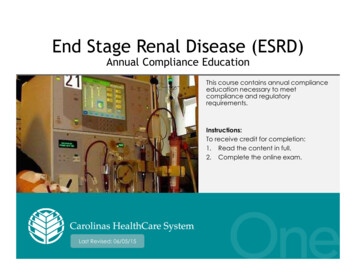
Transcription
End Stage Renal Disease (ESRD)Annual Compliance EducationThis course contains annual complianceeducation necessary to meetcompliance and regulatoryrequirements.Instructions:To receive credit for completion:1. Read the content in full.2. Complete the online exam.Last Revised: 06/05/15
2End Stage Renal Disease (ESRD)WelcomePurpose:To educate all clinical areas about the care and considerations of End Stage RenalDisease in the adult patient.Learning Objectives:When finished with this course, you should be able to: Define End Stage Renal Disease (ESRD) Describe three treatments for ESRD Describe special considerations related to the care of the patient with ESRD State how to access the policies related to ESRDANNUAL COMPLIANCE EDUCATION
3End Stage Renal Disease (ESRD)Defining End Stage Renal Disease (ESRD)Chronic kidney disease (CKD), the precursor to End Stage Renal Disease (ESRD), is aprogressive, irreversible loss in kidney function over a period of months or years. Thestages of CKD kidney loss is based on a person’s Glomerular Filtration Rate (GFR). TheGFR is how much blood passes through the tiny filters of the kidneys per minute.Stage DescriptionGFR LevelNormal Kidney FunctionHealthy kidneys 90 ml/min or moreCKD Stage 1Kidney damage with normal or high GFR 90 ml/min or moreCKD Stage 2Kidney damage and mild decrease in GFR 60-89 ml/minCKD Stage 3Moderate decrease in GFR 30-59 ml/minCKD Stage 4Severe decrease in GFR 15-29 ml/minCKD Stage 5 or ESRDKidney failure less than 15 ml/min or on dialysis The treatment for ESRD is hemodialysis, peritoneal dialysis or a renal (kidney)transplantANNUAL COMPLIANCE EDUCATION
4End Stage Renal Disease (ESRD)Kidneys Role in Maintaining HealthKidneys play a critical role in maintaining health. They: Eliminate waste products through an internal blood filtering systemRegulate blood formation and red blood cell productionRegulate blood pressureControl the body’s delicate chemical and fluid balanceProduce Erythropoietin (EPO), which stimulates the bone marrow to make redblood cellsProduce renin, which regulates blood pressure through electrolyte and waterbalanceANNUAL COMPLIANCE EDUCATION
5End Stage Renal Disease (ESRD)Signs and Symptoms of ESRDCommon signs and symptoms of ESRD rtensionThirstElectrolyteImbalancesUremic Frost(powdery look onskin)EdemaANNUAL COMPLIANCE EDUCATION
6End Stage Renal Disease (ESRD)Dietary ConsiderationsThere are numerous dietary concerns for theadult patient with ESRD: Protein to maintain nitrogen balance Calories to maintain or reach ideal weight Fluid balance Sodium, Potassium and Phosphorous intakeA Renal Dieticiancan help create ameal plan thatcontains the correctamounts and typesof food to meetindividual needsAll ESRD patients MUST have a nutritional screen onadmission.A consult is triggered when an ESRD patient is indicated inthe Electronic Medical Record (EMR).ANNUAL COMPLIANCE EDUCATION
7End Stage Renal Disease (ESRD)ESRD DietsThere are two diets that can be ordered for an ESRD adult patient.Available in CanopyRenal Dialysis DietThis diet is typically for thepatient currently on chronichemodialysis.Renal CKD DietThis diet is typicallyappropriate for patients inCKD stages one through four.The CKD diet is more restrictivethan a dialysis diet.The goal of the diet for hemodialysis is to maintain optimal nutrition while limiting thebuildup of waste products between hemodialysis treatments.ANNUAL COMPLIANCE EDUCATION
8End Stage Renal Disease (ESRD)Common MedicationsScheduled medications, includingantihypertensives, should be given as ordered.Medications should not be held prior to dialysiswithout a Physician’s order.Typical medications for the patient with ESRDinclude: Antihypertensives Vitamin D supplements such as Rocaltrol,Hectorol or Calcitriol Epogen (Procrit) Vitamins and minerals Iron supplements Antibiotics Laxatives, Stool softeners Atarax or Benadryl for itchingANNUAL COMPLIANCE EDUCATION
9End Stage Renal Disease (ESRD)Complications for Patients with ESRDMonitor yourESRD patientsforcomplicationsMonitor for the following:HypertensionChest painHypotensionSeizuresEdemaAir embolism (air bubble trapped inPulmonary edema (fluid in theblood vessels)lungs)HemolysisHyperkalemia (high potassiumBleedinglevel)Clotting of access devicesHypokalemia (low potassium level)Nausea/VomitingInfectionMuscle crampsANNUAL COMPLIANCE EDUCATION
10End Stage Renal Disease (ESRD)Common Medications (continued) Phosphate binders such as Renegal, Renvela and Phoslo- These medications MUST be taken with food- Binders will be given as scheduled and documented by the dialysis nurse while patient is inthe kidney dialysis unit (KDU)- Floor nurse should not “reschedule” on the Electronic Medical Administration Record(eMAR) to allow dialysis nurse to document- Phosphate binders do not have to be sent to the dialysis unit with the patient (KDU hasstock)ANNUAL COMPLIANCE EDUCATION
11End Stage Renal Disease (ESRD)Nursing Considerations Related to ESRDNursing Considerations for patients with ESRD: Vital signsStrict I/ODiet restrictionsFluid restrictionsActivity levelSkin careAccurate daily weight Electrolyte balanceChanges in patientconditionPatient Care Plan(developed by ESRDMultidisciplinary Team)Policies related to ESRD and patients receiving hemodialysis are found onPeopleConnect:PeopleConnectFacilities CHS BRPoliciesPolicy TechANNUAL COMPLIANCE EDUCATION
12End Stage Renal Disease (ESRD)HemodialysisHemodialysis uses a special filter called a dialyzer thatfunctions as an artificial kidney. During treatment, bloodtravels through tubes into the dialyzer which filters out wastesand extra fluids. Most hemodialysis patients go to dialysis three times perweek Three forms of hemodialysis access devices are:1. Arteriovenous fistula (permanent access option)2. Arteriovenous graft (permanent access option)3. Hemodialysis catheters (temporary access option)Hemodialysis access devices are the patients’ lifeline andmust be protected and monitored closely.ANNUAL COMPLIANCE EDUCATION
13End Stage Renal Disease (ESRD)Ateriovenous Fistula & Graft DiagramsArteriovenous Fistula (AVF))Arteriovenous Graft (AVG)ANNUAL COMPLIANCE EDUCATION
14End Stage Renal Disease (ESRD)Ateriovenous Fistula & GraftComparing Arteriovenous Fistula and Graft:Arteriovenous FistulaArteriovenous GraftPatient’s own artery and vein are surgicallyconnected. No artificial material is used.Artificial material that is attached to thepatient’s blood vesselsFound in upper or lower armUsually found in upper or lower arm. May be inthe thigh or chest.Healing time is longer for a fistula than a graftTwo to three weeks healing timeOne incisionTwo incisionsConsidered the BEST vascular access forpatients on dialysisConsidered the second best vascular accessfor patients on dialysisLasts longer than AVG (lasts many years)Does not last as long as AVF and has a higherrisk of clottingHealing time longerCan access earlierLeast risk of infection in comparison to anyother dialysis accessLower risk of infection in comparison tohemodialysis cathetersANNUAL COMPLIANCE EDUCATION
15End Stage Renal Disease (ESRD)Nursing Considerations Related to Fistulas & GraftsConsiderations for Fistulas and Grafts are: Encourage new fistula patients to perform daily exercises by squeezing a ball orrolled up sock (four to five times per day for five to 10 minutes). Daily exercises willprovide growth of the fistula. Examine site, palpate for thrill, auscultate for bruit and document findings Avoid blood pressures or IV sticks of affected arm with AFV or AVG- A sign should be posted above the patient’s bed stating:“No IVs, BPs or lab draws on arm.” Instruct patient to avoid sleeping on affected arm Avoid hypotensive episodes which can cause the access to clot Maintain dressing on access site after hemodialysis for three to four hours Refer to the Care of the Patient Post Hemodialysis PolicyANNUAL COMPLIANCE EDUCATION
16End Stage Renal Disease (ESRD)Hemodialysis CathetersHemodialysis catheters are often used when patients need dialysis immediately or whenpatients have no other access alternatives. Hemodialysis catheters are inserted into the jugular, subclavian or femoral vein The catheter ports are color-coded (red and blue) for accessing the hemodialysis systemAll Catheters: Not ideal as permanent access High infection rates often resulting in seriouscomplications such as sepsis, endocarditis anddeath Difficult to obtain sufficient blood draw for dialysis Less efficient dialysis treatment Swimming and showering not allowedHospitalizations, infections and death increase by50% in patients with catheters compared to those withan AFG or AVG.ANNUAL COMPLIANCE EDUCATION
17End Stage Renal Disease (ESRD)Temporary & Permanent Hemodialysis CathetersComparing Temporary and Permanent Hemodialysis Catheters:Temporary Hemodialysis CatheterPermanent Hemodialysis CatheterUsually stays in one to three weeksCan stay in longer than one yearNurse can remove with a physician’s orderOnly radiology can removeThree types:1. Flexible double lumen (light blue hub)2. Rigid double lumen (teal hub): Strict bedrest if patient has rigid catheter3. Triple lumen catheter with medical portthat can be used like a regular central lineDouble lumen (typically white colored hub)Located at chest or femoral siteLocated at chest site and occasionally atfemoral siteANNUAL COMPLIANCE EDUCATION
18End Stage Renal Disease (ESRD)Nursing Considerations Related to Hemodialysis Catheters Access policies related to hemodialysis catheters via the hospital computer usingthe following pathway:PeopleConnect Facilities –CHS BRPoliciesPolicy TechOnly dialysis nurses or trained nurses are allowed to access the dialysis catheterGain a Nephrologist order before accessing hemodialysis catheters for blooddraws or administration of medications (required)Use a strict aseptic technique when accessing devices. Review policy prior toaccessing.It is important to withdraw the heparin from the catheter prior to accessingDo not get the catheters wet. They can become easily infected.ANNUAL COMPLIANCE EDUCATION
19End Stage Renal Disease (ESRD)Peritoneal DialysisPeritoneal Dialysis (PD) uses the peritoneal membrane as a filter to remove wastes andexcess fluids from the blood. The PD catheter is used for peritoneal dialysis to instill and remove fluidsFor all peritoneal dialysis patients:The PD catheter is never access withoutan order from the Nephrologist and canonly be done by a trained peritonealnurse.This includes accessing thecatheter for peritoneal fluid samples orcultures.ANNUAL COMPLIANCE EDUCATION
20End Stage Renal Disease (ESRD)Nursing Considerations Related to Peritoneal Dialysis Only PD trained nurses can perform PD NEVER move or unplug the PD machine, even whenthe patient is not being dialyzed Place the patient in a private room Never use scissors near the tenckoff catheter andtugging on the catheter should be avoided Encourage patients to wash their catheter site daily orevery other day with antibacterial soap, once healed Consult with a dietician to confirm the same renal dietand fluid restriction the patient was on at home isordered while inpatientDaily Assessments:Fluid balanceWeightBlood pressureLung soundsEdemaElectrolyteimbalance, such ashypokalemiaBowel function(constipation can causeproblems in the dialysisprocess)ANNUAL COMPLIANCE EDUCATION
21End Stage Renal Disease (ESRD)Renal TransplantsRenal Transplant patients: Are provided a functioning kidney from either a living or deceased donor tosomeone with ESRD Are not cured by the renal transplant Must take medications for the rest of their lives to prevent rejection of the organCommon Medications for Renal TransplantPatients Immunosuppressants- Prograf (Tacrolimus)- Prednisone- Cellcept or Myfortic- Sirolimus- CylclosporinAntihypertensivesANNUAL COMPLIANCE EDUCATION
22End Stage Renal Disease (ESRD)Nursing Considerations Related to Renal Transplant PatientsDuring transplant surgery, the patient receives IV “induction therapy” (a strongimmunosuppressant medication) Prograf is one of the immunosuppressants givento prevent rejection of the kidney These medications should be given at specificA patient will typically be ona combination ofimmunosuppressantmedicationstimes Prograf levels must be drawn prior to the AMdose unless otherwise ordered Grapefruit juice affects absorption ofimmunosuppressants, such as Prograf, andmust be avoided Any disruption or change in medicationdelivery can put the patient at risk for rejectionANNUAL COMPLIANCE EDUCATION
23End Stage Renal Disease (ESRD)Nursing Considerations Related to Renal Transplant Patients (continued) Standard Precautions and Protective EnvironmentPrecautions should be used, including:- Strict hand hygiene- Strict ureteral catheter care and maintenance- Strict central line care and maintenance Elevated temperature (100.5) can indicate infectionor rejection and must be monitored A decrease in urine output can indicate rejection orgraft dysfunction and must be monitored Accurate daily weights must be taken Regular diet, without restrictions, can be followed unlessotherwise orderedANNUAL COMPLIANCE EDUCATION
24End Stage Renal Disease (ESRD)ESRD Patient EducationESRD Patient Education at CMCESRD New PatientEducationalManual EducationalMagnet All patients that are newly diagnosed with ESRD are provided a manualThe manual can be found electronically on Careline (CMCC – patientinstructions – ESRD PT Educational Manual)A nursing order can be entered under “ESRD new patient education”Patients that have hemodialysis catheters placed receive aneducational magnet titled “Caring for you Short Term Catheter”The magnet is given with catheter placement in radiology or withtreatment in KDUHemodialysisAccess Education KDU nurses educate new hemodialysis patients on the importance ofobtaining a fistula or graft and how to care for their catheter until apermanent access is obtainedESRD Link A telephone-based self-management program for patients that:- Are frequently readmitted (in less than 30-90 days of prioradmission)- Lack a support system- Are medically non-compliantESRD SupportGroup Support group for patients and familiesThe Social Worker educates patients receiving dialysis about this groupopportunityANNUAL COMPLIANCE EDUCATION
End Stage Renal Disease (ESRD): Job AidPurpose: Use this job aid as a guide for the care of patients with ESRD. Chronic Kidney Disease (CKD) is classified into 5 stages based on a person’s estimated GFR. CKDStage 5 is End Stage Renal Disease (ESRD). ESRD is the loss of function in both kidneys and is irreversible The three treatments for ESRD are hemodialysis, peritoneal dialysis or a renal transplant Patients on dialysis should be on a dialysis diet unless otherwise ordered by their Nephrologist On admission, all patients with ESRD must have a Nutritional and Medical Social Work screening Nursing considerations for the patient with ESRD include strict standard precautions, I/O, dailyweights and monitoring electrolyte balance Beds must be zeroed on admission for accurate weights Policies related to ESRD, including accessing the hemodialysis catheter, are located onPeopleConnect Only PD trained nurses are to perform peritoneal dialysis Immunosuppressant medications for renal transplant patients are taken at specific times. Anydisruption in delivery puts the patient at risk for rejection.ANNUAL COMPLIANCE EDUCATION25
26End Stage Renal Disease (ESRD)SummaryEnd Stage Renal Disease involves progressive, irreversible destruction of both kidneys.This course discussed the considerations, treatments and procedures for ESRD, such ashemodialysis, peritoneal dialysis and renal (kidney) transplant.The following are some strategies reviewed in this course: Define End Stage Renal Disease (ESRD) Describe three treatments for ESRD Describe special considerations related to the care of the patient with ESRD State how to access the policies related to ESRDANNUAL COMPLIANCE EDUCATION
End Stage Renal Disease (ESRD) Chronic kidney disease (CKD), the precursor to End Stage Renal Disease (ESRD), is a progressive, irreversible loss in kidney function over a period of months or years. The stages of CKD kidney loss is based on a person's Glomerular Filtration Rate (GFR). The
